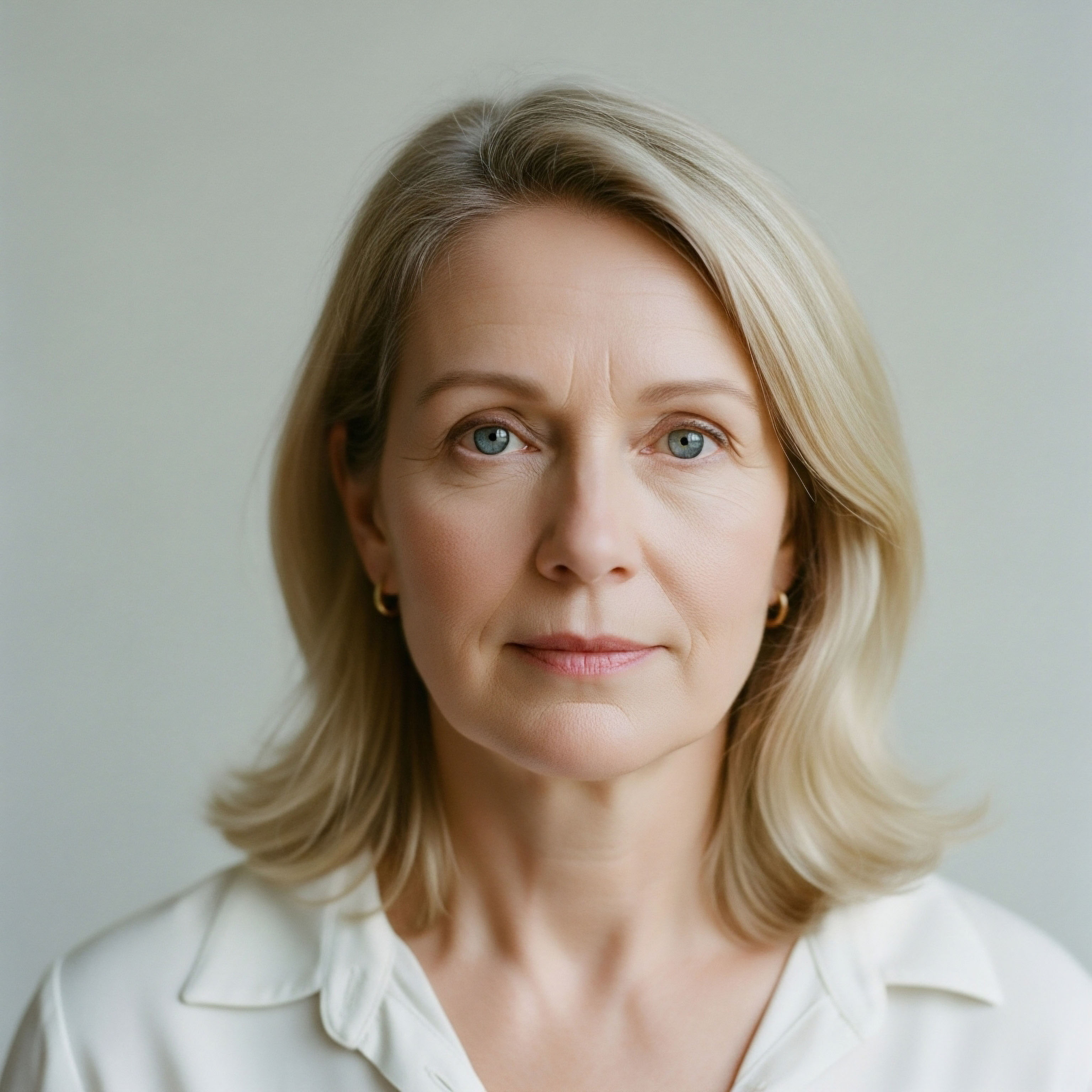

Fundamentals
You may have noticed changes in your hair. Perhaps it feels thinner, or you see more of it in the shower drain. This experience, this very personal and often distressing observation, is a valid starting point for a deeper conversation about your body’s internal environment. Your hair is a sensitive barometer, reflecting the intricate shifts occurring within your endocrine system. Understanding the language of your hormones is the first step toward addressing these changes with clarity and confidence.
The life of a single hair is a dynamic, cyclical process. It moves through distinct phases of growth, transition, and rest. This entire process is orchestrated by a complex interplay of chemical messengers, with hormones acting as the primary conductors.
Think of your hair follicles as tiny, responsive engines, and hormones as the signals that tell them when to rev up, when to idle, and when to shut down for a period. When this signaling system is in balance, the cycles proceed in a harmonious, asynchronous rhythm across your scalp, maintaining a consistent density of hair.
The journey of your hair’s health is deeply intertwined with the nuanced fluctuations of your body’s hormonal symphony.
Disruptions to this delicate hormonal equilibrium, which are a natural part of life’s transitions like menopause for women or andropause for men, can alter these signals. A decline in certain hormones or a shift in the ratio between them can shorten the growth phase or prematurely push a larger number of hairs into the resting and shedding phase.
This is often the underlying reason for the changes you are observing. It is a biological process, a direct consequence of a changing internal landscape, and something that can be understood and addressed through a systematic approach to restoring balance.

The Hormonal Influence on the Hair Growth Cycle
To appreciate the effects of hormonal optimization, one must first understand the key players and their roles. Estrogen, progesterone, and testosterone each exert a unique influence on the hair follicle, and their collective balance is what truly matters for long-term hair health.

Estrogen’s Role in Hair Health
Estrogen is generally considered a hair-friendly hormone. It helps to prolong the anagen, or growth, phase of the hair cycle. This means that individual hairs are allowed to grow for a longer period before they are shed, contributing to fuller, thicker-looking hair.
During times of high estrogen, such as pregnancy, many women experience their best hair. Conversely, the decline in estrogen that characterizes perimenopause and menopause can lead to a shortening of this growth phase, resulting in a more noticeable rate of shedding and a reduction in overall hair volume.

The Influence of Progesterone
Progesterone also plays a part in the complex hormonal regulation of hair growth. While its direct effects are less pronounced than those of estrogen or androgens, it can influence hair health indirectly. Some research suggests that progesterone may help to counteract the effects of androgens at the hair follicle, potentially offering a protective benefit. However, fluctuations in progesterone levels, particularly the decline seen in menopause, can contribute to the overall hormonal imbalance that affects the hair cycle.

Testosterone and Its Derivatives
Testosterone’s role in hair health is more complex and often misunderstood. In both men and women, testosterone can be converted into a more potent androgen called dihydrotestosterone, or DHT. For individuals with a genetic predisposition, DHT is the primary culprit in androgenetic alopecia, also known as male or female pattern hair loss.
DHT can bind to receptors in the hair follicles, causing them to shrink or “miniaturize.” This process shortens the growth phase and results in progressively finer, shorter hairs until, eventually, the follicle may cease to produce hair altogether. The sensitivity of the hair follicles to DHT is genetically determined, which explains why hormonal shifts affect individuals’ hair so differently.


Intermediate
Moving beyond the foundational understanding of hormonal influence, we can begin to explore the specific strategies involved in hormonal optimization and their direct implications for hair health. The goal of these protocols is to restore a more youthful and balanced hormonal environment, which can, in turn, positively affect the hair growth cycle. It is a process of recalibrating the body’s internal messaging system to support optimal function, including the function of the hair follicles.
When embarking on a hormonal optimization protocol, it is common to experience a temporary period of adjustment. Just as the initial hormonal shifts of menopause or andropause can trigger hair shedding, so too can the introduction of therapeutic hormones. This is a normal response of the hair follicles to a change in their biochemical environment.
Think of it as a system-wide reboot; as the new hormonal signals are introduced, some hair follicles may be pushed into a synchronized shedding phase. This initial shedding is typically transient and gives way to a new, more stable growth pattern as the body acclimates to the optimized hormonal levels. Patience and consistency are key during this initial phase.

Protocols for Male Hormonal Optimization and Hair
For men experiencing the symptoms of low testosterone, a comprehensive approach to hormonal optimization is often employed. This typically involves not just replacing testosterone but also managing its potential downstream effects to ensure a balanced and beneficial outcome.
A standard protocol might involve weekly intramuscular injections of Testosterone Cypionate. This serves to restore testosterone levels to a healthy, youthful range, which can improve energy, mood, and libido. However, simply adding testosterone is only part of the equation. To maintain testicular function and fertility, a medication like Gonadorelin may be included.
Gonadorelin mimics the action of a natural hormone that stimulates the testes to produce their own testosterone, preventing the testicular atrophy that can sometimes occur with testosterone therapy alone.
Furthermore, an important consideration in male hormonal optimization is the management of estrogen. As testosterone levels rise, some of it can be converted into estrogen by an enzyme called aromatase. To prevent an unhealthy elevation of estrogen levels, a medication like Anastrozole, an aromatase inhibitor, is often prescribed.
By managing estrogen conversion, potential side effects are minimized, and a more favorable hormonal balance is achieved. This comprehensive approach ensures that the benefits of testosterone are realized without creating other hormonal imbalances that could potentially impact hair health.

Protocols for Female Hormonal Optimization and Hair
For women navigating the hormonal fluctuations of perimenopause and menopause, hormonal optimization protocols are tailored to their specific needs and symptoms. The goal is to replenish declining hormone levels to alleviate symptoms and support long-term health, including the health of the hair.
A typical protocol for women may include low-dose Testosterone Cypionate, administered via subcutaneous injection. This can help to improve energy, mood, and libido, similar to its effects in men. Additionally, Progesterone is often prescribed, particularly for women who still have a uterus, to protect the uterine lining. Progesterone can also contribute to a sense of calm and well-being.
The method of delivery for these hormones can vary, with options like pellet therapy providing a long-acting, steady release of testosterone. In cases where testosterone is used, Anastrozole may also be considered to manage estrogen conversion, just as in men. By carefully balancing these key hormones, female hormonal optimization protocols aim to restore a more stable internal environment, which can help to mitigate the hormonal triggers of hair thinning and support a healthier hair growth cycle.
| Component | Primary Function | Relevance to Hair Health |
|---|---|---|
| Testosterone Cypionate | Restores testosterone levels | Can improve hair quality in some, but must be balanced to manage DHT conversion. |
| Gonadorelin | Maintains natural testosterone production | Supports the overall health of the endocrine system. |
| Anastrozole | Blocks the conversion of testosterone to estrogen | Helps to maintain a healthy testosterone-to-estrogen ratio. |
| Progesterone | Balances estrogen and supports uterine health | May have a protective effect against androgen-related hair loss. |


Academic
A deeper, more technical examination of the long-term effects of hormonal optimization on hair health requires a shift in perspective from the systemic to the cellular level. The hair follicle is a complex mini-organ, a microcosm of the body’s endocrine, vascular, and immune systems. Its fate is determined by a delicate dance of genetic programming and biochemical signaling. Hormonal optimization, from this academic viewpoint, is a targeted intervention in this intricate signaling cascade.
The central mechanism in the story of hormonal hair loss is the enzymatic conversion of testosterone to dihydrotestosterone (DHT) by 5-alpha reductase. This occurs locally, within the cells of the hair follicle itself. In genetically susceptible individuals, the hair follicles on the scalp, particularly in the frontal and vertex regions, possess a higher density of androgen receptors and exhibit increased 5-alpha reductase activity.
When DHT binds to these receptors, it initiates a cascade of intracellular events that ultimately leads to the transcription of genes that shorten the anagen (growth) phase and promote follicular miniaturization. This is the molecular basis of androgenetic alopecia.
Hormonal optimization seeks to modulate the biochemical environment of the hair follicle to favor growth and mitigate the miniaturizing effects of androgens.

The Androgen Paradox Explained
One of the most fascinating aspects of androgen physiology is the so-called “androgen paradox.” This refers to the observation that androgens like testosterone and DHT stimulate hair growth in some areas of the body, such as the beard and chest, while simultaneously causing hair loss on the scalp in genetically predisposed individuals. How can the same hormone have such opposing effects?
The answer lies in the differential expression of androgen receptors and co-regulatory proteins in the cells of hair follicles from different body regions. The specific genetic programming of a scalp hair follicle in an individual with androgenetic alopecia dictates that the binding of DHT will trigger a pathway leading to miniaturization.
In contrast, a beard hair follicle is programmed to respond to the same hormonal signal with increased growth. This highlights the critical importance of genetic context in determining the outcome of hormonal signaling.
- Scalp Follicles ∞ In susceptible individuals, high androgen receptor density and 5-alpha reductase activity lead to DHT-induced miniaturization.
- Beard Follicles ∞ These follicles are programmed to respond to androgens with proliferation and increased hair shaft diameter.
- Body Hair Follicles ∞ The response of these follicles to androgens is variable but generally less pronounced than that of beard follicles.

Peptide Therapies and Their Indirect Influence
While not directly manipulating the primary sex hormones, certain peptide therapies can have a significant, albeit indirect, positive influence on hair health. Peptides are short chains of amino acids that act as signaling molecules in the body. Growth hormone-releasing peptides like Sermorelin and Ipamorelin/CJC-1295 work by stimulating the pituitary gland to release its own growth hormone. This can lead to a host of systemic benefits, including improved cellular repair, enhanced collagen synthesis, and better sleep quality.
These systemic improvements can create a more favorable environment for hair growth. Healthy hair follicles require a robust supply of nutrients and oxygen, as well as efficient cellular repair mechanisms. By supporting the body’s overall regenerative capacity, growth hormone peptide therapies can contribute to healthier, more resilient hair. It is a prime example of the interconnectedness of the body’s systems; by optimizing one aspect of physiology, we can create positive ripple effects throughout the entire organism.
| Peptide | Mechanism of Action | Potential Indirect Benefit for Hair |
|---|---|---|
| Sermorelin | Stimulates natural growth hormone release | Improved cellular repair and regeneration. |
| Ipamorelin / CJC-1295 | Potent and sustained stimulation of growth hormone | Enhanced collagen synthesis and tissue health. |
| PT-141 | Acts on melanocortin receptors to improve sexual function | Primarily for sexual health, with no direct established link to hair growth. |

References
- Stevenson, S. & Thornton, J. (2007). Effect of estrogens on skin aging and the potential role of SERMs. Clinical Interventions in Aging, 2(3), 283 ∞ 297.
- Gasser, S. Heidemeyer, K. & Mbi, C. (2021). Hair loss in women. Medical Clinics, 106(4), 689-704.
- Ustuner, E. T. (2013). Cause of androgenic alopecia ∞ a new theory. Plastic and Reconstructive Surgery Global Open, 1(7), e64.
- Traish, A. M. Hassani, J. Guay, A. T. Zitzmann, M. & Hansen, M. L. (2011). Adverse side effects of 5α-reductase inhibitors therapy ∞ persistent diminished libido and erectile dysfunction and depression in a subset of patients. The journal of sexual medicine, 8(3), 872-884.
- van Zuuren, E. J. Fedorowicz, Z. & Carter, B. (2012). Evidence-based treatments for female pattern hair loss ∞ a summary of a Cochrane systematic review. British Journal of Dermatology, 167(5), 995-1010.

Reflection
The information presented here offers a map of the complex biological territory that connects your hormones to the health of your hair. This knowledge is a powerful tool, a way to translate the signals your body is sending you into a coherent language.
The journey to optimal health is a personal one, a continuous dialogue between your lived experience and the objective data of your own unique physiology. Consider this the beginning of that conversation. The path forward is one of proactive engagement, of asking deeper questions and seeking a personalized strategy that honors the intricate reality of your own biological system. What is your body telling you, and what is the next step in your personal health narrative?

Glossary

hormonal optimization

progesterone

estrogen

hair health

female pattern hair loss

androgenetic alopecia

hair growth cycle

gonadorelin

anastrozole

5-alpha reductase

hair loss

follicular miniaturization

peptide therapies




